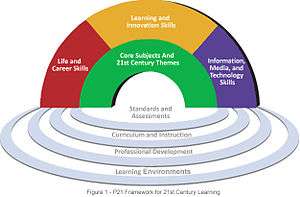Four Cs of 21st century learning
The Four Cs of 21st century learning, also known as the Four Cs or 4 Cs, are four skills that have been identified by the United States-based Partnership for 21st Century Skills (P21) as the most important skills required for 21st century education: critical thinking, communication, collaboration, and creativity.[1][2][3][4][5]
These 21st century skills have been identified and supported by national educational and political leaders in the United States, including President Obama.[6] In January 2016 members of the US House of Representatives created a bipartisan Congressional 21st Century Skills Caucus.[7] The Four Cs have been adopted and implemented into the curricula of schools, school districts, and professional development programs.[8]
Background

In 2002 the Partnership for 21st Century Skills (now the Partnership for 21st Century Learning, or P21) was founded as a non-profit organization by a coalition that included members of the national business community, education leaders, and policymakers: the National Education Association (NEA), United States Department of Education, AOL Time Warner Foundation, Apple Computer, Inc., Cable in the Classroom, Cisco Systems, Inc., Dell Computer Corporation, Microsoft Corporation, SAP, Ken Kay (President and Co-Founder), and Dins Golder-Dardis.[1] The American Management Association's "AMA 2010 Critical Skills Survey" found "that an overwhelming number of respondents believe that these 21st century skills are important to their organizations today and will become even more important in the future."[9]
P21's goal is to foster a national conversation on "the importance of 21st century skills for all students" and "position 21st century readiness at the center of US K-12 education".[1] The organization has released reports exploring how to integrate the Four Cs approach into learning environments.
See also
- Achievement gap
- Deeper learning
- Digital literacy
- Innovation skill
- Learning styles
- Problem solving
- Theory of multiple intelligences
References
- 1 2 3 P21 Our History. Retrieved 2016-03-02
- ↑ P21 Research Series Offers Advice on 21st Century '4Cs, The Journal, 9/02/15. Retrieved 2016-03-03
- ↑ An Educator’s Guide to the “Four Cs”, NEA webpage. Retrieved 2016-03-03
- ↑ The 4Cs: ‘Super skills’ for the 21st Century, Douglas County School District webpage. Retrieved 2016-03-03
- ↑ International Summit on the Teaching Profession - Preparing Teachers and Developing School Leaders for the 21st Century, page 55, Andreas Schleitzer, OECD Publishing, June 7, 2012
- ↑ President Barack Obama, Remarks of the President to the United States Hispanic Chamber of Commerce, White House Office of the Press Secretary, March 10, 2009. Retrieved 2016-03-02
- ↑ P21 News & Events. Retrieved 2016-03-02
- ↑ Becoming a 21st Century School or District: Use the 4Cs to Build Professional Capacity, Edutopia, September 29, 2011. Retrieved 2016-03-03
- ↑ AMA 2010 Critical Skills Survey. Retrieved 12016-03-03